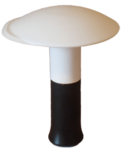 There’s a way to knead dough that produces an elastic and stretchy dough that proofs well and takes a minute or less. The purpose of kneading dough is to stretch and align the gluten fibers in wheat flour. Then the gluten can form an elastic network to capture the gas accumulated as the dough ferments. Yeast organisms in the dough break down wheat starches and release gas in the process. They also multiply and accelerate fermentation, making dough rise and puff up.
There’s a way to knead dough that produces an elastic and stretchy dough that proofs well and takes a minute or less. The purpose of kneading dough is to stretch and align the gluten fibers in wheat flour. Then the gluten can form an elastic network to capture the gas accumulated as the dough ferments. Yeast organisms in the dough break down wheat starches and release gas in the process. They also multiply and accelerate fermentation, making dough rise and puff up.
Lighter, Open Crumb Bread
This airiness is what turns bread dough into bread instead of cooked dough. Bread is truly a wonder of human culture that has sustained whole continents of people for ages. Making bread used to be a common household activity. Nowadays, we don’t learn much bread-making in the family home, but it’s not very difficult, is extremely rewarding, and now there are easy ways to bake bread. There are even no knead breads. No-knead bread recipes abound on the internet, and making bread without kneading does work. However, it takes much longer to turn out a finished no knead loaf, so it can be less convenient than it sounds. In this post we’ll cover how to knead and how long to knead dough to make bread less dense in a way that saves work and time. You can be eating fresh bread in a few hours, if you’re willing to spend a minute kneading your dough.
I chuckle when I watch bread making scenes in TV shows set in earlier times. The actors are often punching their dough and exerting maximum effort just to fold it over. People must have been eating some dense hard loaves back then. These days, you don’t even have to knead with your hands. There are machines and our new hand tool, the Dome, that take most of the work out of kneading. And, though tried and true, hand kneading really doesn’t produce the best results. I’ll show you what I mean.
Kneading with the Dome vs. Hand Kneading
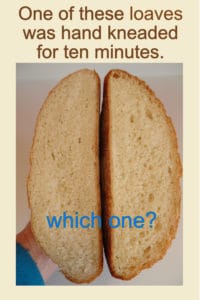 These loaves were made with the same recipe and the same proofing steps for the same proofing time. The loaf on the right has a higher loft and a more open crumb. It’s a better loaf. It was kneaded for one minute with the dome, our new bread-making tool. The one on the left was made the traditional way – mixed with a spoon and hand kneaded for ten minutes. It’s not quite as good. So, why didn’t the hand-kneaded loaf turn out as well, even though I did my best to make a great hand-kneaded loaf?
These loaves were made with the same recipe and the same proofing steps for the same proofing time. The loaf on the right has a higher loft and a more open crumb. It’s a better loaf. It was kneaded for one minute with the dome, our new bread-making tool. The one on the left was made the traditional way – mixed with a spoon and hand kneaded for ten minutes. It’s not quite as good. So, why didn’t the hand-kneaded loaf turn out as well, even though I did my best to make a great hand-kneaded loaf?
I was even surprised by the results. I wanted to prove that the dome would give results as good as hand-kneaded bread with less work and less cleanup. But the dome made better bread!
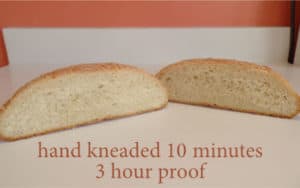
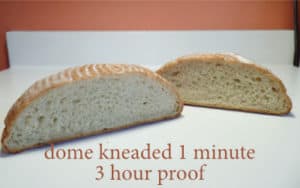
Stretching and Aligning Gluten by Kneading
Some of the difference was due to water content. I had to add 2 additional tablespoons of flour to the hand kneaded dough to be able to knead it at all. And wetter, stickier dough does make a more open crumb, because the moist, lightness of the dough makes for better gluten development.
But there’s also the difference in the effectiveness of the kneading. The dome has the perfect shape for stretching and aligning gluten because it pushes and drags a wide swath of dough at a time, giving it a good stretch. And because you’re turning the bowl as you work, the stretch is radial — in all directions. Evidently, kneading with your hands stretches and aligns the gluten strands less effectively.
No Knead Bread Takes Longer To Proof
How does no-knead bread-making work? It turns out that as soon as wheat meets liquid, the gluten protein activates. Gluten will eventually develop into a network all by itself without any kneading at all. However, it takes a long time to develop into a dough that has enough dough strength to hold a good shape. No knead doughs have to be high in water content, which helps gluten development. But lacking structure, they tend to spread out rather than build up. You usually have to wait until the next day to bake the bread. Here’s a loaf made with the same recipe as the loaves pictured earlier. It took 23 hours at a room temperature that ranged from 68°F (daytime) to 60°F (night time) to fully proof and be ready for baking. It came out well, but took a very long time to get to the baked, ready to eat finale.
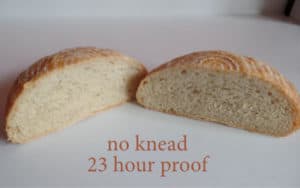
And then there are machines that do the kneading with hook or paddle attachments. They usually have to run for ten or so minutes to do the kneading, and . . . it’s not quite the same as making bread low tech style, by hand, with a simple tool. Watch how to knead with the dome dough maker on the opening video on this page.
Subscribe to this blog for great baking tips and many easy recipes for bread, cookies and more.
